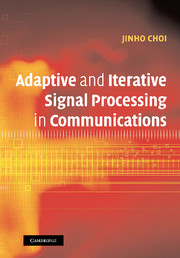Book contents
- Frontmatter
- Contents
- List of figures
- List of tables
- Preface
- List of symbols
- List of abbreviations
- 1 Introduction
- I ISI channels and adaptive signal processing
- II Iterative signal processing for ISI channels
- 5 MAP detection and iterative channel estimation
- 6 Iterative receivers over static ISI channels
- 7 Iterative receivers under time-varying channel conditions
- III Other interference-limited systems
- Appendix 1 Review of signal processing and the Ƶ-transform
- Appendix 2 Important properties of matrices and vectors
- Appendix 3 Background for probability and statistics
- References
- Index
6 - Iterative receivers over static ISI channels
Published online by Cambridge University Press: 23 November 2009
- Frontmatter
- Contents
- List of figures
- List of tables
- Preface
- List of symbols
- List of abbreviations
- 1 Introduction
- I ISI channels and adaptive signal processing
- II Iterative signal processing for ISI channels
- 5 MAP detection and iterative channel estimation
- 6 Iterative receivers over static ISI channels
- 7 Iterative receivers under time-varying channel conditions
- III Other interference-limited systems
- Appendix 1 Review of signal processing and the Ƶ-transform
- Appendix 2 Important properties of matrices and vectors
- Appendix 3 Background for probability and statistics
- References
- Index
Summary
In this chapter, we will study the iterative receiver over static and known ISI channels. When a coded signal is transmitted, the conventional receiver performs the channel equalization (or detection) and the channel decoding separately. Although this approach is not optimal, it has been widely used because of low complexity and simple implementation. On the other hand, a joint processing for the equalization and decoding that can provide an optimal performance cannot be widely used due to the complexity growing exponentially with the length of coded sequences.
Fortunately, using the turbo principle, which was originally proposed for channel decoding (Berrou, Glavieux, and Thitimajshima, 1993; Hagenauer et al., 1996), it becomes possible to build a receiver that can provide a near optimal performance, while maintaining a moderate complexity. It is often called the turbo equalizer (Koetter, Singer, and Tuchler, 2004; Laot, Glavieux, and Labat, 2001; Tuchler, Koetter, and Singer, 2002a) as the turbo principle is adopted. However, we refer to it as the iterative receiver since the turbo equalizer is not only for channel equalization, but also for channel decoding. According to the turbo principle, the channel equalizer and channel decoder exchange the information of bits to achieve a better performance through iterations.
In this chapter, we review information theory and convolutional codes. Both subjects are necessary to understand the iterative receiver. Then, the structure and operation of the iterative receiver are studied. Several different channel equalizers within the iterative receiver and an approach for the performance analysis are also discussed.
A brief overview of information theory
In this section, we briefly introduce the entropy, channel capacity, and mutual information.
- Type
- Chapter
- Information
- Adaptive and Iterative Signal Processing in Communications , pp. 134 - 170Publisher: Cambridge University PressPrint publication year: 2006



